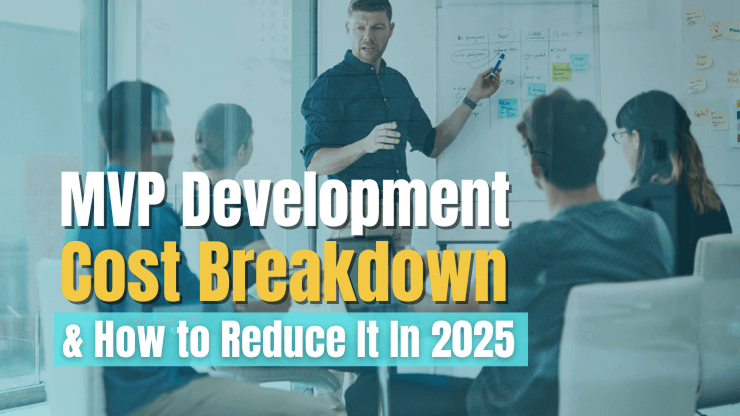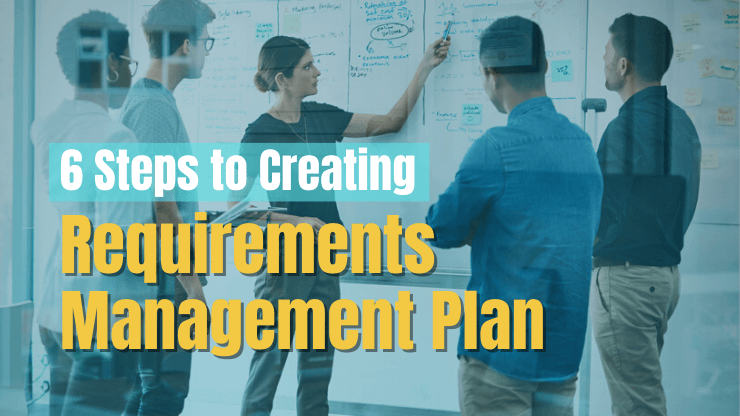No one wants to launch the wrong product. But, the data tells us that launching a product without a market need accounts for 35% of startup failures! That can result in some significant wasted time and money for a new startup.
The good news is: with a little bit of work, you can make sure that your product does fulfill a real market need. This is what a minimum viable product is all about. You want to make sure you have an idea that is viable in the market.
You’ve come to the right place to understand how to build a minimum viable product. Let’s dive right in!
- What is a minimum viable product?
- Why build an MVP?
- MVP vs PoC vs Prototype
- What is a value proposition and why does it matter?
- How to build a minimum viable product in 5-steps [+template]
- Minimum Viable Product Template
- Tips for successful minimum viable product development
- MVP development process costs
- Wrap up - How to build a minimum viable product
What is a minimum viable product?
Although originally coined by Frank Robinson in 2001, the term was brought to the mainstream by Eric Ries in his popular book “The Lean Startup” released in 2011. In short, a minimum viable product (MVP) is defined as a product with just enough features to be usable by real end-users.

Typically, a minimum viable product builds on the development work done during prototyping. The idea is to build a version of the product with all of the basic functionality, release it into the market and use real customer feedback to inform later versions of the product.
Utilizing a minimum viable product is one way of embracing validated learning in the development process. As you learn more about what the early adopters within your target audience like and don't like, what works and what doesn’t, you can adjust your product to better align to the market. Essentially, an MVP is one way to test business hypotheses directly in the market.
Why build an MVP?
So, what’s the purpose of minimum viable product development? Why would you spend your budget on MVP development services? In short, it allows you to more quickly enter the market, get real user feedback, and improve your product iteratively.
The alternative to building a minimum viable product is typically investing in more software development cycles and releasing the product into the market later. While many companies still use this business model, an MVP is a great option to help you time the market better, draw up some initial demand (and revenue), and take cues for future development from the product’s initial customers - all without having to build in all the features you intend to have long term.

Building a minimum viable product is a great option for many early startups and new businesses. A few key benefits you might see include:
- Get useful feedback from your target audience on the product’s basic features.
- Attract early adopters who will likely be your greatest advocates long term.
- Test the waters before committing (time and budget) to a complex future product.
- Focus on developing the core features really well rather than
- Embrace validated learning from the very beginning of the product development lifecycle.
- Attract investors who prefer to see a shipping product instead of just business ideas.
Your custom MVP development project might not reap all of these benefits, but even a few can help to reduce overall product development costs (you focus solely on the product’s core features!) and get your product to market faster (who doesn’t want to see revenue faster?). For these reasons, embracing the MVP development process is a no-brainer for most startups.
But wait…are you sure you need a minimum viable product? Maybe you’re actually in need of a proof of concept (PoC) or prototype…
MVP vs PoC vs Prototype
An MVP is sometimes conflated with a prototype or proof of concept. This leaves room for a lot of confusion, so let’s be really clear before we proceed.
A proof of concept (PoC) is built very early in the product life cycle, often before any investment is raised, a full team is formed, or a formal business idea is established. It is used to prove if a project is feasible or not and if it’s worth further investment. This validation stage is critical as it can help to justify costly design and development work that comes later.
Some teams intend to use their minimum viable product to “prove” viability, and while this is certainly possible, you might consider a low-cost PoC before kicking off minimum viable product work.
A prototype is typically where your product becomes tangible for the first time. It’s meant to give teams an idea of what they are going to build - a way to visualize things for the first time. The level of detail of a prototype can vary significantly.
The lowest budget option would be to sketch out a design with pen and paper. More advanced prototypes can be created in tools such as Figma as interactive designs and tested with real users.
In summary, these three things, while in some ways similar, are each distinct phases of the product development lifecycle. If you’re ready to move forward with a minimum viable product (MVP), we need to start with defining your product’s value proposition.
What is a value proposition and why does it matter?
Your minimum viable product should be clearly aligned to the value proposition of your product. To be minimally viable, it needs to be valuable to your target audience, right? This is where we get to the heart of ensuring we are building the right thing - not just a random set of features. Minimum viable products are always aligned to a well-defined value proposition.
But, what exactly is a value proposition?
A value proposition is a brief statement that outlines what your product or service can do for customers. It includes details on the problem the product or service solves for customers, its main benefit, and how it compares to other options in the market.
A value proposition should:
- Highlight the main benefits of your product or service. This is the heart of your value proposition.
- Detail the problem it solves for its customers. Every viable product solves a real customer problem.
- Compare your product or service against others in the market. This should be based on real market research.
- Be agreed on by all major stakeholders in the company. It’s critical to have alignment on this foundational information.
- Be used as a jumping off point for marketing collateral, messaging, and your product’s tagline.
Before embarking on developing a minimum viable product, you need to be really clear on what your value proposition is. That’s exactly what we’re going to help you do below!
How to build a minimum viable product in 5-steps [+template]
Establishing a substantive value proposition is critical if you want to take your business idea and turn it into a successful product. In its simplest terms, a minimum viable product should be taken as “Minimum Value Proposition.”
Many teams just straight into hiring a software development company, but successful MVP development must be preceded with a critical look at your product idea to ensure you’re building something that has real market value and will yield a high degree of customer satisfaction.
A good starting point for this is developing a statement that explains what benefit you provide for who and how you do it, so let’s start there.
Define the customer’s problem
A problem well stated is a problem half solved. If you don't know what problem your potential customers are trying to solve, you won't be able to build a product that meets their needs. By understanding the problem your customers are trying to solve, you can build a product that is exactly what they need - nothing more and nothing less.
In short, to be able to solve your customer’s problem, you first need to understand it. There are many methods by which you can get to know your target audience and their pain points.
Method 1: Use the Harvard Business School framework to better understand your users and their pain points.
One way is to use the Harvard Business School framework. This framework can actually help you build a complete product strategy, but for our purposes, we can use it to better understand who are users are and what their pain points are.
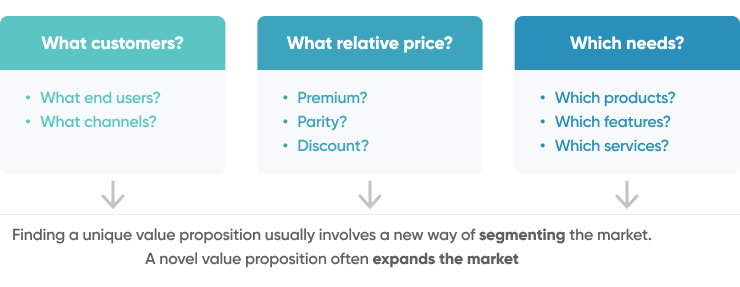
To ensure you first know who your customers are, try asking these questions:
- What is the most common age bracket for your target audience?
- What is the gender breakdown of your target audience?
- What is the financial situation or income for people in your target audience?
- Where do people in your target audience live?
- Does your target audience have children?
Once you’re really clear on who your end users are, you can begin to ask questions to define the main problems they face. We recommend you utilize a small group brainstorm to think through this. Different perspectives will help provide a fuller picture and are more likely to accurately portray your real customers’ problems.
Alternatively, you could invest in gathering new ideas from future customers via surveys or interviews. The means by which you answer these questions is up to you, but the goal should always be to clearly and succinctly capture your customers’ problems.
To get to the heart of your customers’ pain points, try asking these questions:
- What do you know about your end users’ goals?
- What pain points do your users have when trying to achieve their goals?
- In what ways are they trying to get their needs met already?
- What pain points affect measurable results such as revenue or efficiency?
- How urgent is the customer’s problem?
Option 2: Use the 4Us framework to test you are solving the right problem for your users.
Another way you can explore your customers’ problems or pain points is via the 4Us framework. In this framework, the focus is on ensuring you not only understand your customers’ pain points, but that you are focusing on solving the right ones.
A definitive yes to the majority of its questions means you are on the right path toward a compelling value proposition. Otherwise, consider re-evaluating and revising your idea.
- Is the problem Unworkable? Does your solution fix a broken business process where there are real, measurable consequences to inaction?
- Is fixing the problem Unavoidable? Is it driven by company projected growth, market, governance or regulatory changes?
- Is the problem Urgent? Is it one of the top few priorities for a company?
- Is the problem Underserved? Is there absence of valid solutions to the problem you’re looking to solve?
As an output to either (or both) of these methods, you should have a clearly defined customer pain point or problem that you seek to solve, written from the customer’s perspective.
Pain point examples:
- “We are missing out on revenue because we can’t effectively sort, qualify, and prioritize leads.”
- “There are inconsistencies in how our employees use our CRM software, which leads to data mismanagement and disorganization.”
- “We can’t easily see how well our social media marketing campaigns are performing, so we don’t know how to effectively design future campaigns.”
- “Our sales people are not following up with prospects fast enough because they don’t have a good way to keep prospect information organized.”
Find a gap in the market
With your customer pain point in hand, it’s time to think more in depth about how the market is currently addressing (or attempting to address) this pain point. The reason this is so important is because your value proposition will be directly related to the other options customers have.
You need to understand what you’re up against and - ideally - find a gap in the market that you can fill. To do this, we need to evaluate the competition by looking at the products that are already on the market and determine what your product will offer that is different or better. It can also be helpful to look at the pricing of similar products and decide where your product will fit in. Keep in mind:
- Sometimes it’s about solving a customer pain better or more directly.
- Sometimes it’s about solving a customer pain in a new or different way.
- Sometimes it’s about solving a customer pain at a lower cost.
Think about what your strategy is going to be. Your focus might be on solving the pain point more directly AND at a lower cost. Or - you may be solving a customer pain point in a new way that helps to reach a new segment of the market.
A few tips when evaluating the gap you will fill in the market:
- Make sure you know your target market really well. Go back to step one if you feel unsure.
- Look for areas where your target market (or segments of your target market) are underserved.
- Identify in detail how your competitors are positioning their product and solving customer pain points.
- Don’t just rely on delivering the same product as someone else. Looks for ways to add new value or reach an unreached part of the market.
Pro Tip: Ensure you are bringing value to the marketplace.
Think of your ideas in the context of the 3Ds and evaluate if your project opens up the potential for a breakthrough solution for the target market:
- Discontinuous innovations – Does it offer transformative benefits over the status quo? Good enough isn’t good enough if it can be better, and better isn’t good enough if it can be great.
- Defensible technology – Does it create unfair competitive advantage? Data, algorithms (Machine Learning and Artificial Intelligence) and workflow automations are some of the keys to technology advantage.
- Disruptive business model – Does it create value and/or cost optimization that help catalyze the growth of a business?
Measure the gain/pain ratio
One of the most effective exercises for evaluating value proposition is by measuring the gain/pain ratio which compares the benefits obtained from using your idea versus the cost to switch to your solution.
Essentially, the gain/pain ratio is the ratio of the benefits of a proposed action to the costs or drawbacks of that action. It is used to help make decisions about whether to proceed with a particular course of action.

A high gain/pain ratio indicates that the benefits of the action are greater than the costs, while a low gain/pain ratio indicates that the costs are greater than the benefits. Some potential gains and pains include:
| Gain | Pain |
|---|---|
|
|
When developing a new product, you are ideally providing a high gain/pain ratio where the customer sees a lot of benefit with very little pain or drawbacks. Commonly, drawbacks would include a disruption to normal user flow or workflows, significant increase in cost over a current solution, or overhead to learn a complex new tool or product.
You may have an awesome idea for a new product, but you should make sure that your solution offers game-changing benefits with minimal modifications to existing processes or environments. Simply put: disruptive innovation would ideally be non-disruptive to adopt.
It’s critical that your minimum viable product is non-disruptive to achieve success. Strive to deliver an order of magnitude improvement over the status quo. If you can’t deliver a 10x gain/pain promise, users will typically default to “do nothing.”
Build the value proposition
At this point, you’ve deeply understood your customer’s pain points, found a suitable gap in the market, and measured your proposed solution using the gain/pain ratio. Now, it’s time to take your ideas and formulate a clear value proposition statement.
Pro Tip: Consider creating separate value proposition statements for each user group, as they may have distinct pain points and needs that would be better addressed individually.
How you go about writing your value proposition is totally up to you. We��’ve included two methods that we’ve seen work well to help get you started.
Method 1: Ask questions to get to the heart of your value proposition.
Try using this template to succinctly define elements of your value proposition statement. We’re using the Calendly scheduling app as an example.
| Template | Example |
|---|---|
| For target customer | For professionals who do client appointments online |
| Who statement of need or opportunity | Who wants to schedule a meeting with busy experts |
| The product name is a product category | The Callendy is a scheduling tool |
| That key benefit, reason to buy | That takes the work out of “finding time” for meeting with clients |
| Unlike primary competitive alternative | Unlike back-and-forth emails to settle meeting time |
| Our product statement of primary differentiation | Our product allows scheduling meetings professionally and efficiently |
Method 2: Use the Lean Startup Circle process to keep the focus on user benefit instead of features.
The Lean Startup Circle, run by former Google employee, Steve Blank, promotes this simple formula for defining a value proposition:
We help (X) do (Y) by doing (Z).
You can use this simple template to come up with your own value proposition statement. First, sum up who you are trying to reach (go back to step #1 if you’re not sure!). Then, define what your product or service will do to provide value.
A few tips as you develop your own value proposition statement:
- Use language that your customers use. This will help to ensure your message will truly resonate with customers when it’s translated into marketing collateral later.
- Don’t be afraid to test your value proposition in the market. Sometimes the best way to know if you have the right value proposition is to ask real customers.
- Make sure all stakeholders are aligned. This statement will drive what you build and how you build it. Make sure everyone is in alignment before you move on.
Value proposition statement examples:
- Uber We help riders get from point A to point B by providing on demand car service.
- Calendly Our product allows scheduling meetings professionally and efficiently.
- Unbounce We provide A/B testing without tech headaches.
- Slack We help workers everywhere be more productive at work with less effort.
Find the simplest way to solve the problem
The value proposition statement you wrote in step #4 will clearly articulate what value you provide to customers - in other words: how you solve their problem or pain point.
Now it’s time to work out how to build a minimum viable product using that value proposition statement. You may already have some ideas of what your product could look like, but before you get too far, we propose you focus on providing the simplest solution to your customer’s problem.
Far too often companies over-complicate or over-engineer a solution. They fall into the trap of “feature overload” - trying to add every possible feature a customer could want. But this only leads to a confusing product and expensive development costs. On the other hand, when you create a simple solution you see the following two major benefits:
- Reduced costs. Building a simple solution is going to be less complex and lower cost to build and maintain.
- Reduced time to market. Building a simple solution will help you prioritize only the must have features, which reduce overall development time.
- Increased customer satisfaction. Creating an easy to understand product with a singular compelling value proposition will certainly improve customer value and long term satisfaction.
So how do you avoid feature overload and build a minimum viable product that resonates with customers?
The short answer is: embrace the idea that your minimum viable product will not be your final product. You will add more features later. You will make changes and find ways to optimize your product. Don’t try to make your MVP perfect. In fact, if it is, you probably spent far too long in development!
Here are a few tips to make sure you’re staying true to your value proposition statement and building the simplest solution possible:
- Check your MVP feature set against your value proposition statement. Does anything not directly align? If so, cut it.
- Evaluate assumptions you are making about your target audience. You might be building features to satisfy assumptions that simply aren’t true.
- Make sure your core functionality isn’t getting buried in the noise. Your core functionality should be the star of the show. An overloaded feature set could be unintentionally hiding the main value you provide.
- Create a simple feature map. When in doubt, draw out the steps a user would take on your site. Anything that gets in the way of a user achieving their main goal should be questioned.
Minimum Viable Product Template
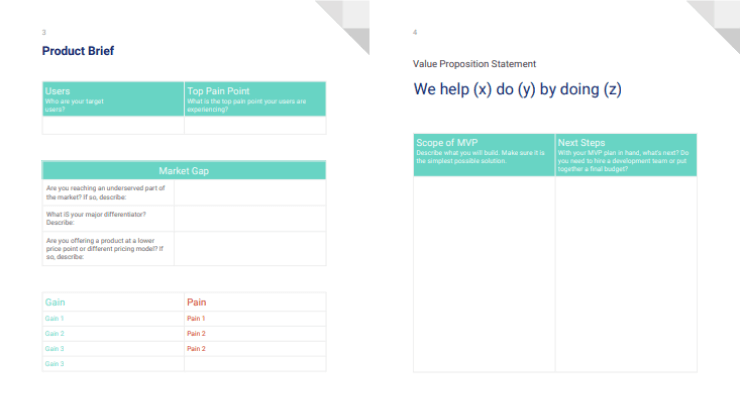
Tips for successful minimum viable product development
Hopefully at this point your key stakeholders have aligned on a value proposition. If not, refer to the 5-step process above!
With that value proposition and product idea in hand, you’re ready to hire an MVP development team and kickoff software development! Here are out top tips for how to build a minimum viable product that succeeds in the market:
Clarify your vision before building
To successfully build a minimum viable product, you first need to be really clear on what your value proposition is. Before you embark on building your future product, we suggest you work through the step by step guide we outlined above (or use the template) to ensure you have a crystal clear value proposition.
Clarifying your value proposition before building a minimum viable product will help to:
- Reduce customer acquisition costs by building a product that solves major pain points of your target users.
- Reduce MVP development cost by helping you to prioritize features that add real value over a long list of features (i.e. feature overload).
- Speed up the development stage and get to market faster by accelerating minimum viable product development.
- Find the best solution to your target users’ pain points amongst all of the possible solutions.
Remember, you can always add additional features during further product development! The goal for all startup founders should be to provide real value for your first users.
Break down requirements into actionable tasks
Developing minimum viable products is not an easy task. Once you’ve settled on a value proposition for your new product, you’ll move into the building phase where you’ll have a very long list of stakeholder requirements. The real skill is turning this list into an actionable list of items that can be built into your minimum viable product software.
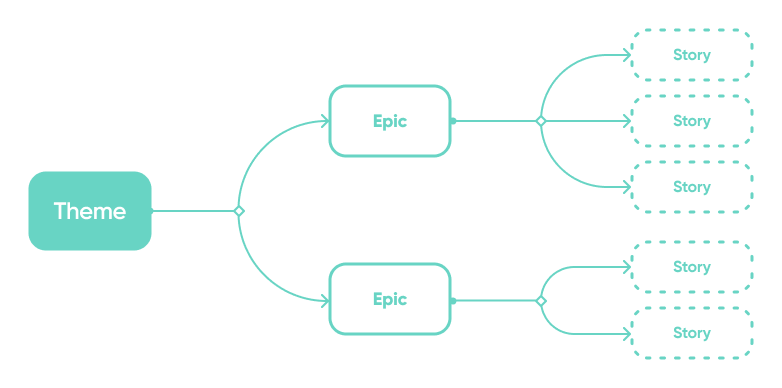
One good way of doing this is by using the process of “User Story Mapping” and grouping related items into “Themes”, building a list of “Epics” that sit underneath these themes and then from these large deliverable epics, create a list of actionable and deliverable “User Stories” (non solutioned, user focused problem statements which can be delivered in a short period of time).
Keep it simple by focusing on solving one big problem
Bear in mind that depending on your organization and their familiarity with lean/agile ways of working, your stakeholders might not be able to bring themselves to reduce their ever-growing requirements list to a suitable sub-set.
This is where expert facilitation and coaching needs to come into play, with a laser focus on objectives, rather than long wish lists of functionality that aren’t essential. A good question to ask is “is it possible to launch without this” or “could the customer still complete their journey without this item.” Do you really need that integration, or could it be managed manually? When in doubt, refer back to step #5 to ensure you’re building the simplest solution.
Make sure you have the right team
There are many options available from working directly with freelance software developers to hiring a dedicated software development team and software product development services. Ideally you may want to focus on finding an experienced team with a track record of minimum viable product development.

MVP development process costs
MVP product development costs come down to three major factors:
- Developers' experience
- Size and scope of the project
- Location of the developers
Generally speaking, developers with a few years of experience can cost anywhere from $50-$100 per hour. More experienced developers can cost $100-$200 per hour or more.
The size and scope of the project is another important factor to consider when budgeting for MVP product development. A small, simple minimum viable product might only take a few weeks to develop and can cost a few thousand dollars. A larger, more complex MVP can take several months to develop and can cost tens of thousands of dollars.
Finally, the location of the MVP development company can also affect the cost. Developers in North America and Western Europe tend to be more expensive than developers in other parts of the world such as outsourcing to Eastern Europe. This is due to a number of factors, including the cost of living in these regions and the availability of experienced developers.
Overall, the cost of hiring developers for your minimum viable product software can vary depending on a number of factors. You should consider what your priorities are to ensure the development team you select aligns with not just your budget but also your expectations for your end product.
Wrap up - How to build a minimum viable product
A famous artist once said “How do I know what I want to create until I start painting?” Once you’ve identified your value proposition, start building something. Start building anything. Create a “strawman” set of wireframes that people can throw rocks at and knock down. Do it as soon as possible.
The development teams may wish to start their work ahead of the first set of requirements being fed in and this is often known as “Sprint Zero”. The development team needs time to get their development environments set up, repositories and other collaboration tools.
Once this has occurred, the key thing is to get something built, firstly so that you can seek a good alignment within the internal team, but more importantly to get something released to your users or customer base so that you start gathering valuable and actionable feedback.
The sooner you release your MVP into the market, the sooner you’ll be able to build a better, more optimized future version of your product. And with that, best outcome for your MVP development!

![Building a Minimum Viable Product in 5 Steps [+ Template]](/.netlify/images?url=_astro%2Fhow-to-build-a-minimum-viable-product.SOXdKh5W.png)
